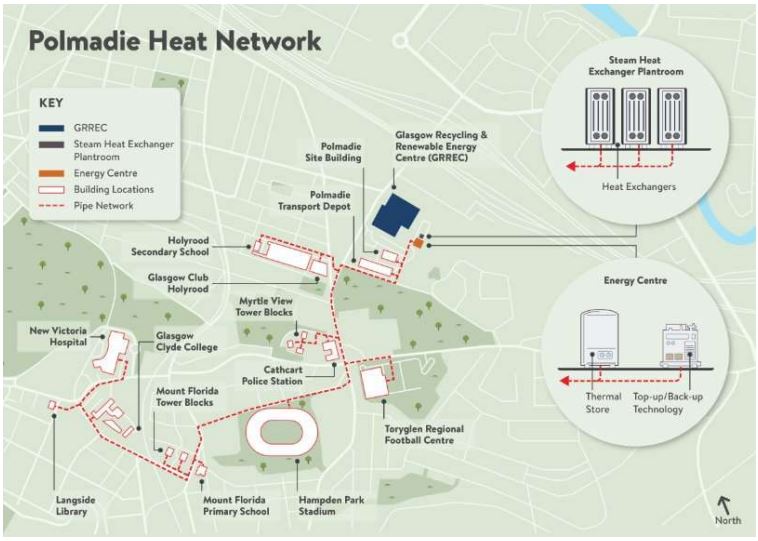Southside buildings and homes could be heated by waste facility, study concludes

An energy from waste plant in the Polmadie area of Glasgow could successfully heat Hampden Park, New Victoria Hospital, schools, a police station, other public facilities and homes across the southside of the city, Glasgow City Council has said.
The announcement follows the conclusion of a feasibility study on the potential to create a district heat network from the Glasgow Recycling and Renewable Energy Centre (GRREC).
The GRREC, operated by waste management company Viridor on behalf of Glasgow City Council, currently sends enough electricity to the National Grid to power the equivalent of up to 26,000 homes. The plant uses various processes to convert household waste into fuel that ultimately drives a turbine to produce renewable electricity.
The high level of heat generated during this process means the GRREC also has the potential to provide low cost, low carbon heating across a city area that includes Mount Florida, Toryglen, Battlefield and Govanhill.
According to the study, an estimated investment of £24.1 million would be required to build the pipe network and other facilities needed for a district heating system. It is anticipated such a system could reduce carbon emissions from domestic heating in the area by 81% even with back-up gas boilers in place. Over the course of a 40-year scheme that would be required to attract the necessary investment, the Polmadie heating network could save over 160,000 tonnes of CO2 from entering the atmosphere.
Councillor Angus Millar, city convener for climate, regards the feasibility study as further confirmation of the potential to decarbonise Glasgow’s heating systems but also the scope to attract the finance needed to create a net zero city.
Councillor Millar said: “How we heat our homes and other buildings is one of the big challenges we face as the city tackles the causes of climate change.
“But this study shows conclusively that heat produced by the GRREC can be used to warm buildings across a wide area on Glasgow’s southside.
“The heat that comes from household waste processed at the GRREC is fully renewable and would make substantial inroads on the carbon emissions from the buildings in this heat zone area.
“The possibility of a district heating network sourced from the GRREC can also help to attract inward investment and create the infrastructure that can support for the push for net zero.
“The GRREC produces reliable heat and this study shows investors should be confident of a return on any investment.
“We are at an early stage with this initiative but we have grounds for optimism that using energy from waste to heat homes and other buildings is realistic and achievable.”
The feasibility study on the GRREC forms part of Glasgow’s Local Heat and Energy Efficiency Strategy, which identified 21 zones across Glasgow where the level of heat demand shows potential for viable district heating systems.
Almost half (46%) of Glasgow homes could heat their homes by connecting to a district heating network. Other options for sources of energy for these proposed networks include extracting natural heat from the River Clyde by using water source heat pumps, drawing heat from deep geothermal wells and tapping into the city’s waste water system.
Glasgow is currently establishing a Green Investment Team that will be tasked with unlocking the £40 billion needed for Glasgow to achieve its net zero ambitions.








